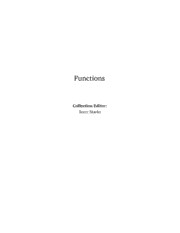
Preview Functions
Functions Collection Editor: Scott Starks Functions Collection Editor: Scott Starks Author: Kenny M. Felder Online: < http://cnx.org/content/col11272/1.2/ > C O N N E X I O N S Rice University, Houston, Texas This selection and arrangement of content as a collection is copyrighted by Scott Starks. It is licensed under the Creative Commons Attribution 3.0 license (http://creativecommons.org/licenses/by/3.0/). Collection structure revised: February 1, 2011 PDF generated: February 6, 2011 For copyright and attribution information for the modules contained in this collection, see p. 52. Table of Contents 1 Function Concepts (cid:21) Introduction ...............................................................1 2 Function Concepts (cid:21) What is a Variable? ......................................................3 3 Function Concepts (cid:21) What is a Function? ......................................................5 4 Function Concepts (cid:21) The Rule of Consistency .................................................7 5 Function Concepts (cid:21) Four Ways to Represent a Function ................. ...................9 6 Function Concepts (cid:21) Domain and Range ......................................................11 7 Function Concepts (cid:21) Functions in the Real World ............................................15 8 Function Concepts (cid:21) Function Notation .......................................................17 9 Function Concepts (cid:21) Algebraic Generalizations ...............................................19 10 Function Concepts (cid:21) Graphing ................................................................23 11 Function Concepts (cid:21) Lines .....................................................................37 12 Function Concepts (cid:21) Composite Functions ...................................................41 13 Function Concepts (cid:21) Inverse Functions .......................................................45 Glossary .............................................................................................50 Index ................................................................................................51 Attributions .........................................................................................52 iv Chapter 1 Function Concepts (cid:21) Introduction1 TheunitonfunctionsisthemostimportantintheAlgebraIIcourse,becauseitprovidesacrucialtransition point. Roughly speaking... • Before Algebra I, math is about numbers. • Starting in Algebra I, and continuing into Algebra II, math is about variables. • Beginning with Algebra II, and continuing into Calculus, math is about functions. Each step builds on the previous step. Each step expands the ability of mathematics to model behavior and solve problems. And, perhaps most crucially, each step can be frightening to a student. It can be very intimidating for a beginning Algebra student to see an entire page of mathematics that is covered with letters, with almost no numbers to be found! Unfortunately, many students end up with a very vague idea of what variables are ((cid:16)That’s when you use letters in math(cid:17)) and an even more vague understanding of functions ((cid:16)Those things that look like f(x) or something(cid:17)). If you leave yourself with this kind of vague understanding of the core concepts, the lessons will make less and less sense as you go on: you will be left with the feeling that (cid:16)I just can’t do this stu(cid:27)(cid:17) without realizing that the problem was all the way back in the idea of a variable or function. The good news is, variables and functions both have very speci(cid:28)c meanings that are not di(cid:30)cult to understand. 1Thiscontentisavailableonlineat<http://cnx.org/content/m18192/1.4/>. 1 2 CHAPTER 1. FUNCTION CONCEPTS (cid:21) INTRODUCTION Chapter 2 Function Concepts (cid:21) What is a Variable?1 A variable is a letter that stands for a number you don’t know, or a number that can change. A few examples: Example 2.1: Good Examples of Variable De(cid:28)nitions • (cid:16)Let p be the number of people in a classroom.(cid:17) • (cid:16)Let A be John’s age, measured in years.(cid:17) • (cid:16)Let h be the number of hours that Susan has been working.(cid:17) In each case, the letter stands for a very speci(cid:28)c number. However, we use a letter instead of a number becausewedon’tknowthespeci(cid:28)cnumber. Inthe(cid:28)rstexampleabove,di(cid:27)erentclassroomswillhavedi(cid:27)erent numbersofpeople(sopcanbedi(cid:27)erentnumbersindi(cid:27)erentclasses); inthesecondexample, John’sageisa speci(cid:28)c and well-de(cid:28)ned number, but we don’t know what it is (at least not yet); and in the third example, h will actually change its value every hour. In all three cases, we have a good reason for using a letter: it represents a number, but we cannot use a speci(cid:28)c number such as (cid:16)(cid:21)3(cid:17) or (cid:16) 41(cid:17). 2 Example 2.2: Bad Examples of Variable De(cid:28)nitions • (cid:16)Let n be the nickels.(cid:17) • (cid:16)Let M be the number of minutes in an hour.(cid:17) The (cid:28)rst error is by far the most common. Remember that a variable always stands for a number. (cid:16)The nickels(cid:17) are not a number. Better de(cid:28)nitions would be: (cid:16)Let n be the number of nickels(cid:17) or (cid:16)Let n be the total value of the nickels, measured in cents(cid:17) or (cid:16)Let n be the total mass of the nickels, measured in grams.(cid:17) The second example is better, because (cid:16)number of minutes in an hour(cid:17) is a number. But there is no reason to call it (cid:16)The Mysterious Mr. M(cid:17) because we already know what it is. Why use a letter when you just mean (cid:16)60(cid:17)? Bad variable de(cid:28)nitions are one of the most common reasons that students get stuck on word problems(cid:22)or get the wrong answer. The (cid:28)rst type of error illustrated above leads to variable confusion: n will end up being used for (cid:16)number of nickels(cid:17) in one equation and (cid:16)total value of the nickels(cid:17) in another, and you end up with the wrong answer. The second type of error is more harmless(cid:22)it won’t lead to wrong answers(cid:22)but it won’t help either. It usually indicates that the student is asking the wrong question ((cid:16)What can I assign a variable to?(cid:17)) instead of the right question ((cid:16)What numbers do I need to know?(cid:17)) 1Thiscontentisavailableonlineat<http://cnx.org/content/m18194/1.5/>. 3 4 CHAPTER 2. FUNCTION CONCEPTS (cid:21) WHAT IS A VARIABLE? 2.1 Variables aren’t all called x. Get used to it. Many students expect all variables to be named x, with possibly an occasional guest appearance by y. In fact,variablescanbenamedwithpracticallyanyletter. Uppercaseletters,lowercaseletters,andevenGreek lettersarecommonlyusedforvariablenames. Hence,aproblemmightstartwith(cid:16)LetH bethehometeam’s score and V be the visiting team’s score.(cid:17) Ifyouattempttocallbothofthesevariablesx,itjustwon’twork. Youcouldinprinciplecalloneofthem x and the other y, but that would make it more di(cid:30)cult to remember which variable goes with which team. It is important to become comfortable using a wide range of letters. (I do, however, recommend avoiding the letter o whenever possible, since it looks like the number 0.)
